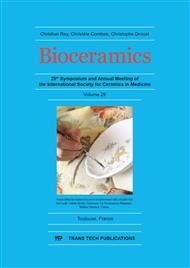p.228
p.234
p.239
p.245
p.250
p.255
p.264
p.269
p.273
Preliminary Study for Co-Culture of Osteoblasts and Endothelial Cells to Construct the Regenerative Bone
Abstract:
Vascularization is a crucial process during bone development and regeneration. A number of studies have shown that the interaction between osteoblasts and endothelial cells plays a key role in osteogenesis by using co-culture system. However, vascularization strategies in cell-based bone tissue engineering depend on optimal culture conditions. In this study, we determined the optimal co-culture conditions in view of osteogenic parameters and examined the effects of angiogenic properties on osteogenesis. As for cell proliferation, the proportion of osteoblasts increased and that of endothelial cells decreased as culture period passed. Assessment of osteogenic differentiation shows that co-culture of osteoblasts and endothelial cells significantly increased alkaline phosphatase activity and expression of bone-related genes. Furthermore, abundant microcapillary-like structures were observed which endothelial cells self-assembled into branches and net-like structures. The use of endothelial cells would be a promising strategy to promote vascularization to support the bone regeneration. Combination of these cell-based approaches and tissue engineering like three-dimensional scaffolds could provide a novel treatment therapy for bone defects and bone diseases.
Info:
Periodical:
Pages:
269-272
Citation:
Online since:
November 2017
Authors:
Keywords:
Price:
Сopyright:
© 2017 Trans Tech Publications Ltd. All Rights Reserved
Share:
Citation:


